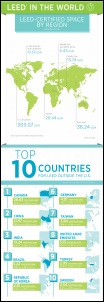by Brianna Crandall — July 24, 2015—The U.S. Green Building Council (USGBC) announced on July 22 its international rankings of the Top 10 Countries for its widely used Leadership in Energy and Environmental Design (LEED) green building rating system.
The Top 10 list highlights countries outside of the USA that are making significant strides in sustainable building design, construction and transformation, illustrating the ever-growing international demand for LEED green buildings. The announcement comes at a time of increased international focus on climate change mitigation in the lead up to the United Nations’ COP21 climate negotiations this December.
The 10 countries that made the list for 2015 are geographically and culturally diverse, representing seven of the world’s 20 largest single-nation economies by gross domestic product (GDP) (China, Germany, Brazil, India, Canada, South Korea and Turkey), as well as six of the top 11 emitters of greenhouse gases (China, India, Germany, South Korea, Canada and Brazil).
While Canada tops the list, Brazil and the Republic of Korea have moved up in the rankings, and Turkey and Sweden are new to the Top 10 this year.
This is the second year that USGBC has provided rankings on the Top 10 Countries for LEED outside of the United States. The analysis used to develop the list ranks countries in terms of gross square meters and numbers of LEED projects to date.
Overview
Canada ranks number one on the list as the largest user of LEED outside of the U.S. with 26.63 million GSM of LEED space. There are now over 4,814 LEED-registered and LEED-certified projects representing 63.31 million GSM of LEED space in Canada. China (21.97 million GSM), India (13.24 million GSM) and Brazil (5.22 million GSM), three of the four BRIC economies, finished second through fourth on this year’s list, respectively.
These three countries currently represent more than 33 percent of global greenhouse gas emissions, with China and India representing the largest source of projected growth in global emissions in the coming decades.
East Asia
The Republic of Korea (4.81 million GSM) and Taiwan (3.84 million GSM) join China in providing a strong East Asian contingent to the 2015 rankings. Having two of the original tiger economies join China, India and Brazil on this year’s list demonstrates that LEED is taking hold in some of the world’s fastest growing economies, and that green buildings have enormous strategic value in terms of controlling emissions in countries that many climate watchers have noted hold the key to staving off the worst impacts of climate change.
Europe
Germany (4.01 million GSM) and Sweden (2.54 million GSM) represent Europe on this list, with Germany finishing sixth and Sweden making the list for the first time in 10th place. Both nations are routinely cited for their innovation and leadership in international efforts to reduce greenhouse gas emissions.
Middle East
Middle Eastern countries, United Arab Emirates (3.13 million GSM) and Turkey (2.95 million GSM) have both had strong green building years. The UAE increased its total amount of LEED-certified space by 72 percent over last year, and climbed from ninth place overall in 2014 to eighth overall in 2015. Turkey made the Top 10 list for the first time in the nation’s history, finishing ninth overall.
The full ranking is as follows:
- Canada
- China
- India
- Brazil
- Republic of Korea
- Germany
- Taiwan
- United Arab Emirates
- Turkey
- Sweden
The United States, the birthplace of LEED, is not included in this list but remains the world’s largest market for LEED. The USA is the world’s largest economy by GDP as well as the world’s second largest emitter of greenhouse gases, adds the USGBC.
According to the USGBC, LEED-certified spaces use less energy and water resources, save money for families, businesses and taxpayers, reduce carbon emissions, and create a healthier environment for residents, workers and the larger community.
There are currently more than 69,800 commercial and institutional projects representing 1.23 billion GSM of space participating in the green building rating system. LEED projects can now be found in more than 150 countries and territories across the world.





